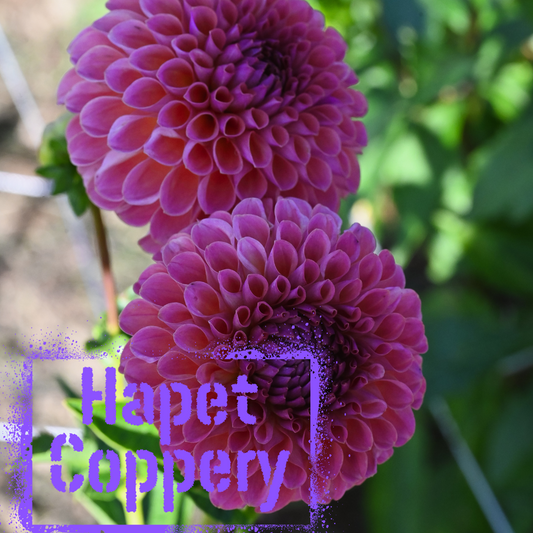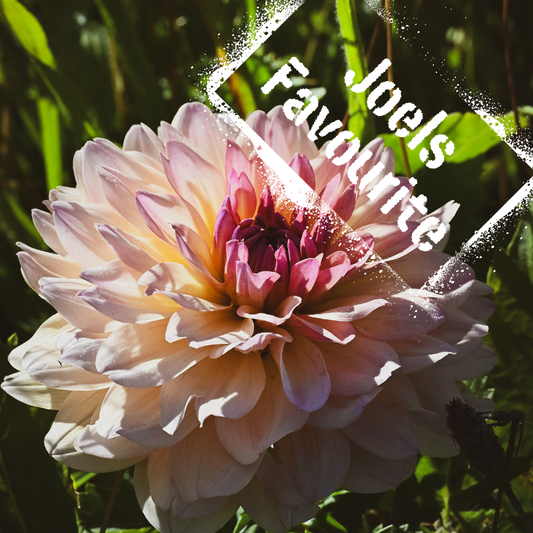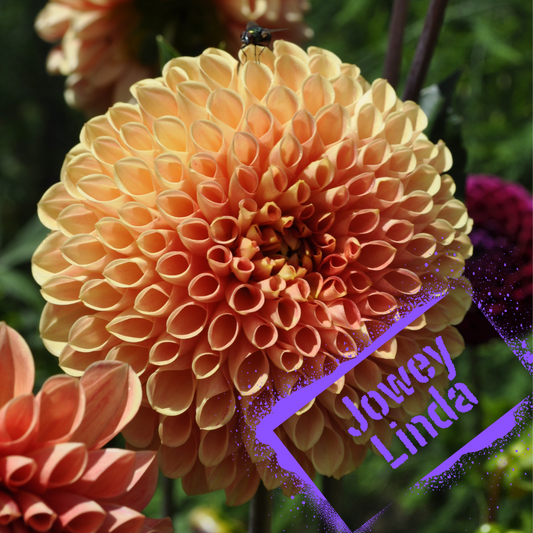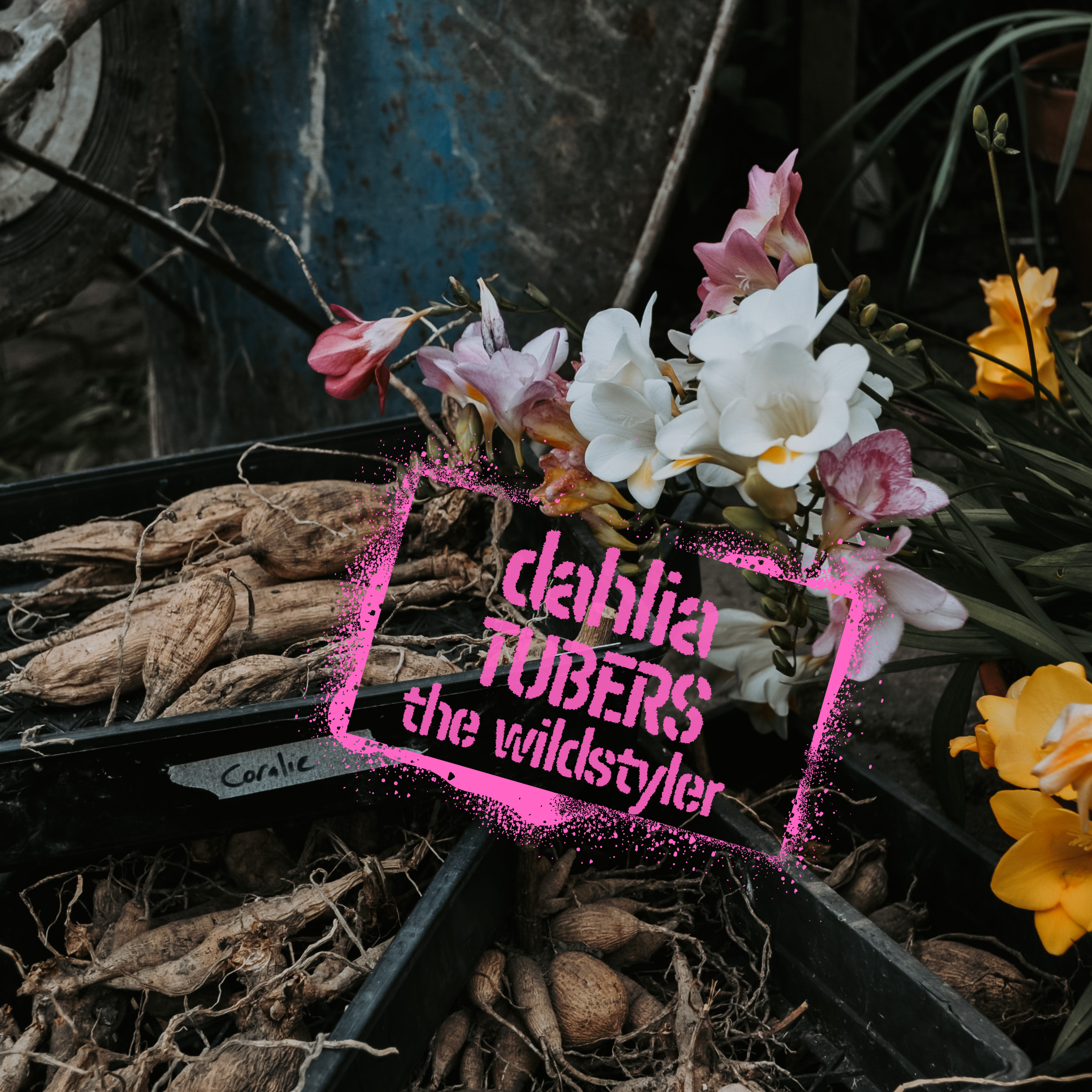SOLD OUT FOR 2024 - Next tuber sale is August 2025
Bring a burst of vibrant colour and unique charm to your garden with our premium dahlia tubers.
Known for their stunning, bold blooms and wide range of colours and forms, dahlias are the perfect addition to any garden, whether you’re looking to create a statement flower bed or simply add a pop of colour to your outdoor space.
Why Choose Dahlias from The Wildstyler?
Hand-Selected Quality
Our dahlia tubers are carefully hand-picked to ensure they are of the highest quality, giving you the best chance for strong, healthy plants and abundant blooms.
Best Variety of Colours and Forms
We offer a diverse selection of dahlia varieties, from classic dinner plate dahlias to more unusual forms. You'll find colours ranging from deep burgundies and rich purples to soft pastels and bright, eye-catching oranges.
Ideal for Cut Flowers
Dahlias are well-known for their long-lasting blooms, making them ideal for cutting and bringing indoors to enjoy in vases.
Easy to Grow
Whether you’re a seasoned gardener or a beginner, our dahlia tubers are easy to plant and care for, with detailed planting instructions provided below.
Details:
Availability: Limited stock available in late Winter/early Spring.
Shipping: We offer fast NZ-wide shipping to ensure your tubers arrive in perfect condition, ready for planting.
Planting & Care Tips
Planting Time: Dahlias should be planted after the last frost, typically in late spring, in NZ we recommend planting on or around Labour Weekend.
Sunlight: Choose a sunny spot in your garden where your dahlias can receive at least 6 hours of sunlight per day.
Soil: Well-drained, rich soil is ideal for growing dahlias. Consider adding compost or other organic matter to enrich the soil.
Watering: Water regularly, but be careful not to overwater, as dahlias prefer moist but not waterlogged soil.
Support: Tall dahlia varieties may require staking to support the heavy blooms.
Enhance your garden with the vibrant and versatile beauty of dahlias.
---
Please read the "Dahlia Tuber - important info" below, before purchasing tubers.
-
 Sold out
Sold outFrans Kafta
Regular price $20.00 NZDRegular priceUnit price / per -
 Sold out
Sold outGolden Scepter
Regular price $20.00 NZDRegular priceUnit price / per -
 Sold out
Sold outHapet Coppery
Regular price $25.00 NZDRegular priceUnit price / per -
 Sold out
Sold outHonka Fraglie
Regular price $20.00 NZDRegular priceUnit price / per -
 Sold out
Sold outJoal Kaitlin
Regular price $25.00 NZDRegular priceUnit price / per -
 Sold out
Sold outJoel’s Favourite
Regular price $30.00 NZDRegular priceUnit price / per -
 Sold out
Sold outJowey Linda
Regular price $20.00 NZDRegular priceUnit price / per -
 Sold out
Sold outKarma Chocolate
Regular price $20.00 NZDRegular priceUnit price / per -
 Sold out
Sold outKarma Serena
Regular price $20.00 NZDRegular priceUnit price / per -
 Sold out
Sold outLilac Time
Regular price $20.00 NZDRegular priceUnit price / per -
 Sold out
Sold outLinda's Baby
Regular price $25.00 NZDRegular priceUnit price / per -
 Sold out
Sold outLucky Dip Dahlia
Regular price $20.00 NZDRegular priceUnit price / per -
 Sold out
Sold outMelissa Anna Marijke
Regular price $20.00 NZDRegular priceUnit price / per -
 Sold out
Sold outMicks Peppermint
Regular price $20.00 NZDRegular priceUnit price / per -
 Sold out
Sold outMisses Miley
Regular price $20.00 NZDRegular priceUnit price / per -
 Sold out
Sold outMolly Raven
Regular price $30.00 NZDRegular priceUnit price / per -
 Sold out
Sold outMoor Place
Regular price $25.00 NZDRegular priceUnit price / per -
 Sold out
Sold outMums Special
Regular price $20.00 NZDRegular priceUnit price / per -
 Sold out
Sold outMuzzy's Delight
Regular price $20.00 NZDRegular priceUnit price / per -
 Sold out
Sold outNuit d Ete
Regular price $20.00 NZDRegular priceUnit price / per -
 Sold out
Sold outOrange Peaches n' Cream
Regular price $25.00 NZDRegular priceUnit price / per -
 Sold out
Sold outPeaches N’ Cream
Regular price $25.00 NZDRegular priceUnit price / per -
 Sold out
Sold outPerch Hill
Regular price $25.00 NZDRegular priceUnit price / per -
 Sold out
Sold outPetras Wedding
Regular price $20.00 NZDRegular priceUnit price / per -
 Sold out
Sold outPink Suffusion
Regular price $25.00 NZDRegular priceUnit price / per
Dahlia Tubers - Important Info and T&C's
Tuber Purchasing Guidelines
1. Limited Quantities: Each dahlia variety is limited to a maximum of two tubers per customer.
2. Pricing Details: Our dahlia tubers are priced based on the care they require. Some varieties are slightly more expensive, not due to popularity, but because they demand extra attention throughout the season. These varieties are more sensitive to weather extremes - heat, cold, humidity, or drought - and are notoriously difficult to divide and store. They often produce fewer tubers or more feeder tubers, requiring additional care over winter. For example, 'Peaches' is one such variety that can be challenging, but her stunning beauty makes her worth the effort. If you're looking for a low-maintenance, hardy dahlia that blooms abundantly and returns year after year, 'Cabana Banana' is the perfect choice—she's practically indestructible!
3. Shipping Information: Dahlia tubers will be shipped shortly after your order is placed. You'll receive an email notification as soon as they’re on their way. While we’d love to care for these little beauties longer, it’s time for them to leave the nest. You'll be responsible for storing your tubers until planting time.
4. Shipping Options: Please make sure to select the correct shipping option at checkout. If you have a rural delivery (RD) address, you must choose RD shipping to avoid delays in your order.
5. Tuber Size & Condition: Tubers come in various shapes and sizes, but size isn’t the priority—what matters is that your tuber has a viable neck and crown with eyes. Most will be single tubers, but some may arrive as small clumps. Each tuber has been inspected for viable eyes during dividing, and the cut edges have been treated with flowers of sulfur to protect against disease.
6. Tuber Inspection: Please inspect your tubers upon arrival. If you have any concerns, contact us within 48 hours with details and photos. We will not accept returns or offer refunds on dahlia tubers after this time.
7. Care Responsibility: You are responsible for the care of your tubers from the time they arrive until planting. Visit our blog on tuber care and planting to ensure your dahlias get the best start.
8. Disease Precautions: The Wildstyler takes numerous precautions to prevent the introduction and spread of disease, including quarantining new varieties and regularly sanitising tools. Our tubers are NZ-grown for at least one season and inspected at multiple stages - planting, lifting, dividing, and dispatch. We guarantee that all tubers are free from visible signs of pests or disease at the time of dispatch. However, please note that disease can exist in your soil or be transmitted by insects, and we cannot be held responsible for any disease that may develop during the growing season.
9. Terms & Conditions: By purchasing our tubers, you agree to these terms and conditions and acknowledge the information provided above.
Availability Note: Dahlia tubers are in high demand, and they sell out quickly. Even if you’re quick at checkout, items may still disappear from your cart as others complete their purchases faster. Unfortunately, adding a tuber to your cart does not guarantee it will still be available at checkout. We appreciate your understanding.
Get Your Dahlia Fix: If you’re not already addicted to dahlias, you soon will be! The Wildstyler offers a variety of dahlias, including Dinner Plate, Cactus, Decorative, Pompon, Ball, Fubuki, Orchid, and Collarette types. Whether you’re starting your dahlia collection or adding to it, we’ve got you covered.
Stay Updated: Like The Wildstyler on Facebook or Instagram for release dates and news.

Tuber care & planting
Dahlia tubers are not like ordinary bulbs or corms, they require special attention in order to grow. Below are tips to get the best out of your tubers.
Dahlia Tuber Care
Tuber Care
Store your new arrivals in a cool, dark, dry, spot, until you are ready to plant. Dahlia tubers can make a tasty treat for rodents so be sure to keep them away from little critters. The dahlias may decide to sprout in the bag and thats okay.
Tuber Planting
Dahlia tubers are cold sensitive and will only produce roots in optimal ground temperatures of around 15 degrees celsius. Care should be taken not to plant tubers too early in the season. If a tuber is planted before the ground temp rises, you risk losing them to rot. In New Zealand, it is recommended to start planting your tubers in October at the earliest (depending on your location).
Once the threat of frost has passed and the ground temp rises, plant your tubers in well draining, fertile, soil. If you don't have free draining soil, raised garden beds work a treat.
Plant your tuber 10cm deep, and at least 30cm apart from other tubers. Overcrowding can cause outbreaks of powdery mildew.
It is recommended to stake your dahlia now, in order to avoid stakes piercing tubers at a later date.
Tips
*Only water your dahlias once they have started to produce green shoots. This is usually about 3-4 weeks after planting.
*If you have the space, start your dahlias indoors. Greenhouse, garage, spare room, anywhere! Doing this can save the heartbreak of losing them to rot by planting them outdoors too early, and can also give you the chance to check them for disease before moving them to your garden bed.
Taking Cuttings
A great way to increase your stock for summer. Take your dormant tuber and plant in shallow potting mix with the top of the tuber clump exposed. At this stage the clump/tuber does not need to be watered. Keep indoors for this process as too much moisture will rot your tuber. Your tuber should start to wake up after around 3-6 weeks. When the shoot is about 8cm long, take a knife and cut out the shoot from where it first appears on the tuber. Remove the lower leaves and pinch out the top. Dip the end in hormone rooting powder, and push into damp potting mix. Cover with a plastic bag and keep out of direct sunlight. After a few weeks, your cutting should have developed roots and will be ready for the garden once the threat of frost has passed. Be sure to protect your cuttings from slugs and snails.
Dahlia Pinching
To get the best from your plants, it is recommended to pinch out the top of the main stem. This promotes the growth of multiple stems from just above the cut which, in turn, gives you way more flowering stems with a longer stem length. Pinch out once your dahlia has produced around 4 sets of leaves.
Staking
Dahlias get tall and heavy, especially those dinner plate varieties. A downpour of rain can snap flower stems in an instant. Staking your blooms helps provide the support needed to bloom again and again. It is best to pop your stakes into the ground BEFORE planting your tuber. This stops the stake potentially going straight through the tuber after planting.
Feeding
Once in bloom, dahlias thrive when fertilised monthly with a good balanced organic liquid fertiliser. This is especially the case if you are growing your dahlias in containers.
If adding compost, make sure it is bought from a reputable supplier and free of pesticides and herbicides. If adding animal manures, make sure these are well aged before adding.
Dahlias love Bone Flour and Organic Potash - both high in Potassium (K).
Harvesting
Cut your dahlia blooms early morning or late in the evening. Dahlia blooms aren't the longest lasting cut flower, they will usually look good for 4-5 days in a vase. It is important to harvest them at the right time of development as they wont unfurl much more once cut. So make sure they are not too closed or too open. Cut long stems and place immediately into a bucket of water. Pick your blooms every 3-4 days to encourage a constant supply of flowers.
Collecting Seed
A fun and exciting part of growing dahlia, is the seed! If you leave your blooms to set seed (usually best at the end of the season as your plant is winding down) you have a few surprises in store for next season. Unlike tubers, dahlia seeds will never be 100% true to their parent, so what will grow, is anyones guess. Wait until the seed head is brown and dry, give it a squeeze to check. No moisture should come out. If it is dry, cut and store - as is - in a dark, cool and dry place, until next season.
Problems
Dahlias are generally easy care provided you have the right conditions. They are prone to rot and powdery mildew. To avoid these, watch your watering before the tuber has sprouted and plant in well draining soil and remove the lower leaves of dahlia plants to encourage airflow and stop powdery mildew. The only other threat to your dahlias are slugs and snails.... don't get me started! These pests can decimate a garden of newly sprouted dahlia shoots in one night. You could use bait. We prefer not to do this, so I usually spend my mornings and evenings covering and uncovering newly emerging shoots with bottles that will protect from slug damage but still allow the plant to breathe. It is time consuming. Another option is to head out at dusk and pick off the little critters or use a beer/yeast trap to catch them in. Its all very gross, but all a part of growing dahlias!
Earwigs are generally the only other pest we encounter here. They do a fair bit of damage to the blooms as they burrow in to the bud and have a snack before they open.
Other issues on the rise include crown gall and leafy gall. There is plenty of info online about these and what to look out for. Although it isn't super common, it is increasing. Unfortunately, there is no cure for either, and plants should be destroyed - into the bin, not the compost.
Lifting Tubers
It is recommended to lift your dahlias each year or every second year. This promotes healthy future plants for the coming seasons by keeping clumps small and stoping over crowding and preventing tuber loss through rot over the winter. Lifting can also help find pests and diseases quickly, and possibly save the rest of your garden from nasties like gall and pesky ants, who love to nest in burrowed out tubers.
Tubers can be lifted around 4 weeks after the dahlia foliage has died down, any earlier and you risk losing your tubers in storage as they haven't had a chance to harden.
Lift tuber clumps with a garden fork, not spade. I lost many a tuber in the early days due to a spade going straight through the center.
Tuber Storage
There are so many recommended ways to store tubers online. Some, I feel, are a bit over the top. Here at The Wildstyler, tubers are lifted around 3-4 weeks after the foliage has died back. If lifted earlier than this, the tubers have not had a chance to harden and will shrivel in storage. Another bonus of not lifting until then, the shorter day length kick starts tuber production. So leaving them in the ground that little bit longer, means more (and usually bigger) tubers for next season.
After being lifted, the entire clump is rinsed under the hose, left in the shade overnight to dry (not in the sun) and then placed on shelves in a cool, dark shed. Thats it! The shed has a natural airflow with small vents at the top and is secure from little rodents wanting a tasty treat. I check them every so often and give them a little squeeze, but so far have had no issues with storing tubers this way. Come spring, the clumps are divided and ready to plant. I find that clumps always store better than single tubers and there is less chance of loss. There is usually enough moisture and energy in the clump to sit out the winter, all ready for spring.
Tuber Dividing
Here at The Wildstyler, I only divide tubers before planting. As mentioned, I find the tuber clumps store better over the winter months than singular tubers do.
There are many online videos on how to divide dahlia tubers. The key things to remember - for a dahlia tuber to sprout, it needs a neck, a crown and eyes. I suggest doing a little bit of research on what to look out for before having a go on your dahlia clump.




































